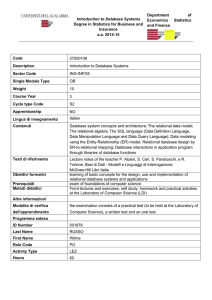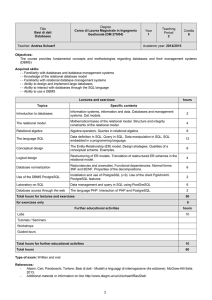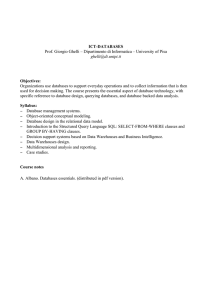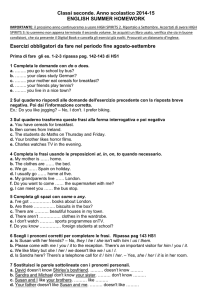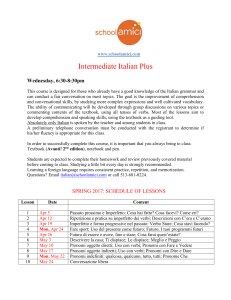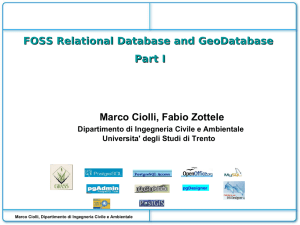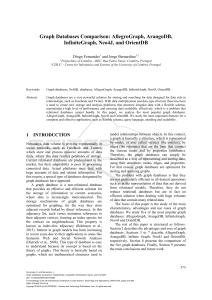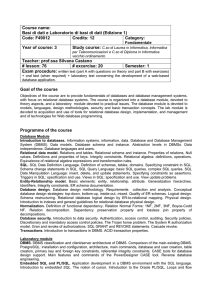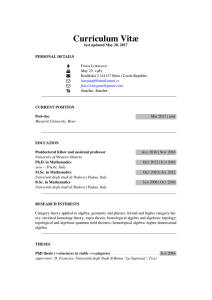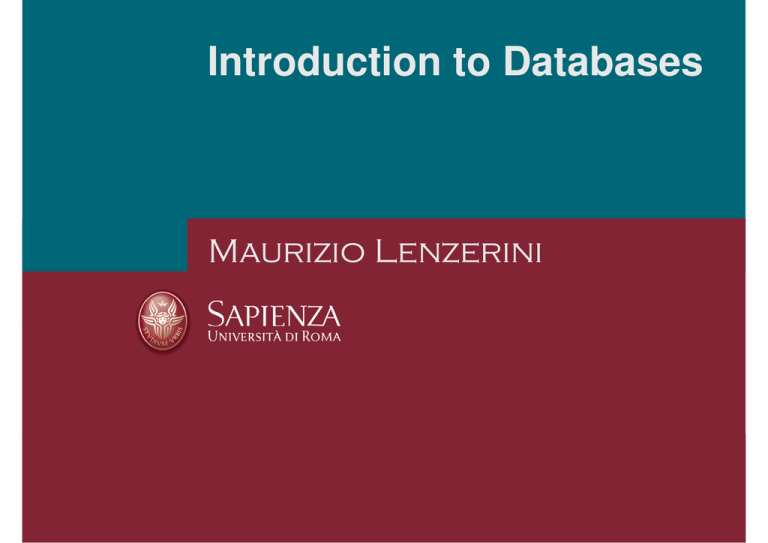
Introduction to Databases
Maurizio Lenzerini
Acknowledgments
This material is based on a set of slides prepared by
Prof. Phokion Kolaitis (University of California, Santa
Cruz, USA)
I thank Prof. Phokion Kolaitis for letting me use his
material
M. Lenzerini - Introduction to databases
2
Fare clic per modificare stile
Outline
1. The notion of database
2. The relational model of data
3. The relational algebra
4. SQL
M. Lenzerini - Introduction to databases
3
Fare clic per modificare stile
Outline
1. The notion of database
2. The relational model of data
3. The relational algebra
4. SQL
M. Lenzerini - Introduction to databases
4
The Notion of Database
The term “database” may refer to any collection of data stored in
a computing system. Here, we use it with a specific meaning:
integrated repository of the set of all relevant data of an
organization.
Application 1
File 1
Application N
File N
Application 1
Database
Application 1
M. Lenzerini - Introduction to databases
predatabase
situation
(60’s-70’s)
post-database
situation
5
Three-layer Software Architecture
The Database Management System (DBMS) is the software
system responsible of managing the database. Data in the
database are accessible only through such system.
Presentation layer
Application layer
Client1
Application1
.
.
.
.
.
.
Clientn
Applicationn
Data layer
Database
DBMS
Application Server
M. Lenzerini - Introduction to databases
6
Fare clic per
Databases
and
modificare
Databasestile
Management Systems
– A database is a collection of inter-related data organized in
particular ways, and managed by a DBMS.
– A database management system (DBMS) is a set of
programs that allows one to carry out at least the following
tasks:
• Create a (persistent) database.
• Insert, delete, modify (update) data in a database.
• Query a database “efficiently (ask questions and extract
information from the database).
• Ensuring “correctness” and “availability” in data management
– DBMS’s are different from File Systems
– Example: “Find all customers whose address has 95060 as zip
code” is an easy task for a DBMS, but may require a new program
to be written in a file system.
M. Lenzerini - Introduction to databases
7
Key Characteristics of DBMS’s
Every DBMS must provide support for:
• A Data Model: A mathematical abstraction for
representing/organizing data.
• At least one high-level Data Language: Language for defining,
updating, manipulating, and retrieving data.
• Mechanisms for specifying and checking Integrity Constraints:
Rules ad restrictions that the data at hand must obey – e.g., different
people must have different SSNs.
• Transaction management, concurrency control & recovery
mechanisms:
Must not confuse simultaneous actions – e.g.,
two deposits to the same account must each credit the account.
• Access control:
Limit access of certain data to certain users.
M. Lenzerini - Introduction to databases
8
Applications of Database Management Systems
• Traditional applications:
– Institutional records
• Government, Corporate, Academic, …
• Payroll, Personnel Records, …
– Airline Reservation Systems
– Banking Systems
• Numerous new applications:
–
–
–
–
Scientific Databases
Electronic Health Records
Information Integration from Heterogeneous Sources
Databases are behind most of the things one does on the
web:
• Google searches, Amazon purchases, eBay auctions, …
M. Lenzerini - Introduction to databases
9
Data Languages
A Data Language has two parts:
• A Data Definition Language (DDL) has a syntax for describing
“database templates” in terms of the underlying data model.
• A Data Manipulation Language (DML) supports the following
operations on data:
–
–
–
–
Insertion
Deletion
Update
Retrieval and extraction of data (query the data).
The first three operations are fairly standard. However, there is
much variety on data retrieval and extraction (Query
Languages).
M. Lenzerini - Introduction to databases
10
Fare
A
Brief
clic
History
per modificare
of Data Models
stile
• Earlier Data Models (before 1970)
– Hierarchical Data Model
• Based on the mathematical notion of a tree.
– Network Data Model
• Based on the mathematical notion of a graph.
• Relational Data Model – 1970
– Based on the mathematical notion of a relation.
• Entity-Relationship Model – 1976
– Conceptual model; used mainly as a design tool.
• Semi-structured Data Model and XML – late 1990s
– Based on SGML and the mathematical notion of a tree (the
Hierarchical Model strikes back!).
• Data Model of Graph-databases – 2000s
M. Lenzerini - Introduction to databases
11
Fare clic per
Relational
Databases:
modificareAstile
Very Brief History
• The history of relational databases is
the history of a scientific and
technological revolution.
Edgar F. Codd, 1923-2003
• The scientific revolution started in 1970
by Edgar (Ted) F. Codd at the IBM San
Jose Research Laboratory (now the
IBM Almaden Research Center)
• Codd introduced the relational data
model and two database query
languages: relational algebra and
relational calculus.
– “A relational model for data for large
shared data banks”, CACM, 1970.
– “Relational completeness of data
base sublanguages”, in: Database
Systems, ed. by R. Rustin, 1972.
12
M. Lenzerini - Introduction to databases
12
Fare clic per
Relational
Databases:
modificareAstile
Very Brief History
• Researchers at the IBM San Jose Laboratory embark on the
System R project, the first implementation of a relational
database management system (RDBMS) – see the paper by
Astrahan et al.
– In 1974-1975, they develop SEQUEL, a query language that eventually
became the industry standard SQL.
– System R evolved to DB2 – released first in 1983.
• M. Stonebraker and E. Wong embark on the development of
the Ingres RDBMS at UC Berkeley in 1973.
– Ingres is commercialized in 1983; later, it became PostgreSQL, a free
software OODBMS (object-oriented DBMS).
• L. Ellison founds a company in 1979 that eventually becomes
Oracle Corporation; Oracle V2 is released in 1979 and Oracle
V3 in 1983.
• Ted Codd receives the ACM Turing Award in 1981.
• Database research is still very active today
13
M. Lenzerini - Introduction to databases
13
Fare clic per modificare stile
Outline
1. The notion of database
2. The relational model of data
3. The relational algebra
4. SQL
M. Lenzerini - Introduction to databases
14
FareRelational
The
clic per modificare
Data Model
stile
(E.F. Codd – 1970)
• The Relational Data Model uses the mathematical concept of a
relation as the formalism for describing and representing data.
• Question: What is a relation?
• Answer:
– Formally, a relation is a subset of a cartesian product of sets.
– Informally, a relation is a “table” with rows and columns.
CHECKING-ACCOUNT Table
branch-name
account-no
customer-name
balance
Orsay
10991-06284
Abiteboul
$3,567.53
Hawthorne
10992-35671
Hull
$11,245.75
…
…
…
…
15
M. Lenzerini - Introduction to databases
15
Basicclic
Fare
Notions
per modificare
from Discrete
stile Mathematics
• A k-tuple is an ordered sequence of k objects (need not be
distinct)
– (2,0,1) is a 3-tuple; (a,b,a,a,c) is a 5-tuple, and so on.
• If D1, D2, … , Dk are k sets, then the cartesian product D1 × D2
… × Dk of these sets is the set of all k-tuples (d1,d2, …,dk) such
that di ⊆ Di, for 1 ≤ i ≤ k.
• Fact: Let |D| denote the cardinality (# of elements) of a set D.
Then |D1 × D2 × … × Dk| = |D1|× |D2| × … × |Dk|.
• Example: If D1 = {0,1} and D2 ={a,b,c,d}, then |D1× D2| = 8.
• Warning: In general, computing a cartesian product is an
expensive operation!
16
M. Lenzerini - Introduction to databases
16
Fare clic
Basic
Notions
per modificare
from Discrete
stile Mathematics
• A k-ary relation R is a subset of a cartesian product of k sets,
i.e., R ⊆ D1× D2× … × Dk.
• Examples:
– Unary
R = {0,2,4,…,100} (R ⊆ N)
– Binary
L = {(m,n): m < n} (L ⊆ N×N)
– Binary
T = {(a,b): a and b have the same birthday}
– Ternary S = {(m,n,s): s = m+n}
– …
17
M. Lenzerini - Introduction to databases
17
Fare clic per
Relations
andmodificare
Attributesstile
R ⊆ D1× D2 × … × Dk can be viewed as a table with k columns
Definition: An attribute is the name of a position (column) of a
relation (table).
Table R
In the CHECKING-ACCOUNT Table below, the attributes are
branch-name, account-no, customer-name, and balance.
CHECKING-ACCOUNT Table
branch-name
account-no
customer-name
balance
Orsay
10991-06284
Abiteboul
$3,567.53
Hawthorne
10992-35671
Hull
$11,245.75
…
…
…
…
18
M. Lenzerini - Introduction to databases
18
Fare clic Schemas
Relation
per modificare
and Relations
stile
Definition: A k-ary relation schema R(A1,A2,…,AK) is a named
ordered sequence (A1,A2,…,Ak) of k attributes (where each
attribute may have a data type declared).
Examples:
– COURSE(course-no, course-name, term, instructor, room, time)
– CITY-INFO(name, state, population)
– Option: course-no:integer, course-name:string
Thus, a k-ary relation schema is a “blueprint”, a “template” or a “structure
specification” for some k-ary relation.
Definition: An instance of a relation schema is a relation
conforming to the schema:
The arities must match;
If declared, the data types must match.
19
M. Lenzerini - Introduction to databases
19
Fare clic per
Relational
Database
modificare
Schemas
stile and Relational Databases
Definition: A relational database schema is a set of relation
schemas Ri(A1,A2,…,Aki), for 1 ≤ i≤ m.
Example: BANKING relational database schema with relation
schemas
– CHECKING-ACCOUNT(branch, acc-no, cust-id, balance)
– SAVINGS-ACCOUNT(branch, acc-no, cust-id, balance)
– CUSTOMER(cust-id, name, address, phone, email)
– ….
Definition: A relational database instance or, simply, a relational
database of a relational schema is a set of relations Ri each of
which is an instance of the corresponding relation schema Ri, for
each 1 ≤ i≤ m.
20
M. Lenzerini - Introduction to databases
20
Fare clic per
Relational
Database
modificare
Schemas
stile - Examples
Examples:
• BANKING relational database schema with relation schemas
–
–
–
–
CHECKING-ACCOUNT(branch, acc-no, cust-id, balance)
SAVINGS-ACCOUNT(branch, acc-no, cust-id, balance)
CUSTOMER(cust-id, name, address, phone, email)
….
• UNIVERSITY relational database schema with relation
schemas
–
–
–
–
–
STUDENT(student-id, student-name, major, status)
FACULTY(faculty-id, faculty-name, dpt, title, salary)
COURSE(course-no, course-name, term, instructor)
ENROLLS(student-id, course-no, term)
…
Note: In general, a relational schema may have infinitely many
different relational database instances.
21
M. Lenzerini - Introduction to databases
21
Fare clic per
Schemas
vs. modificare
Instances stile
Keep in mind that there is a clear distinction between
– relation schemas and instances of relation schemas
and
– relational database schemas and relational database
instances.
Syntactic Notion
Semantic Notion
(discrete mathematics notion)
Relation Schema
Instance of a relation schema
(i.e., a relation)
Relational Database Schema
Relational database instance
(i.e., a database)
22
M. Lenzerini - Introduction to databases
22
Fare clic
Query
Languages
per modificare
for thestile
Relational Data Model
Codd introduced two different query languages for the relational
data model:
• Relational Algebra, which is a procedural language.
– It is an algebraic formalism in which queries are expressed by applying a
sequence of operations to relations.
• Relational Calculus, which is a declarative language.
– It is a logical formalism in which queries are expressed as formulas of
first-order logic.
Codd’s Theorem: Relational Algebra and Relational Calculus are
essentially equivalent in terms of expressive power.
DBMSs are based on yet another language, namely SQL, a hybrid
of a procedural and a declarative language that combines features
from both relational algebra and relational calculus.
23
M. Lenzerini - Introduction to databases
23
Fare clic perfor
Desiderata
modificare
a Database
stile
Query Language
Desiderata:
I. The language should be sufficiently high-level to secure
physical data independence, i.e., the separation between the
physical level and the conceptual level of databases.
II. The language should have high enough expressive power to
be able to pose useful and interesting queries against the
database.
III. The language should be efficiently implementable to allow for
the fast retrieval of information from the database.
Warning:
There is a well-understood tension between desideratum II
and desideratum III.
Increase in expressive power comes at the expense of
efficiency.
24
M. Lenzerini - Introduction to databases
24
Fare clic per modificare stile
Outline
1. The notion of database
2. The relational model of data
3. The relational algebra
4. SQL
M. Lenzerini - Introduction to databases
25
FareFive
The
clic per
Basic
modificare
Operations
stile
of Relational Algebra
Operators of Relational Algebra:
• Group I: Three standard set-theoretic binary operations:
– Union
– Difference
– Cartesian Product
• Group II. Two special unary operations on relations:
– Projection
– Selection
• Relational Algebra consists of all expressions obtained by
combining these five basic operations in syntactically correct
ways.
26
M. Lenzerini - Introduction to databases
26
Fare clic per
Relational
Algebra:
modificare
Standard
stile Set-Theoretic Operations
• Union
– Input: Two k-ary relations R and S, for some k.
– Output: The k-ary relation R ∪ S, where
R ∪ S = {(a1,…,ak): (a1,…,ak) is in R or (a1,…,ak) is in S}
• Difference:
– Input: Two k-ary relations R and S, for some k.
– Output: The k-ary relation R - S, where
R - S = {(a1,…,ak): (a1,…,ak) is in R and (a1,…,ak) is not in S}
• Note:
– In relational algebra, both arguments to the union and the
difference must be relations of the same arity.
– In SQL, there is the additional requirement that the
corresponding attributes must have the same data type.
– However, the corresponding attributes need not have the
same names; the corresponding attribute in the result can be
renamed arbitrarily.
27
M. Lenzerini - Introduction to databases
27
Fare clic per modificare stile
Union
Employee
Code
7274
7432
9824
Director
Name
Rossi
Neri
Verdi
Age
42
54
45
Employee
Code
7274
7432
9824
9297
M. Lenzerini - Introduction to databases
Code
9297
7432
9824
Name
Neri
Neri
Verdi
Age
33
54
45
∪ Director
Name Age
Rossi
42
Neri
54
Verdi
45
Neri
33
28
Fare clic per modificare stile
Difference
Employee
Code
7274
7432
9824
Director
Name
Rossi
Neri
Verdi
Age
42
54
45
Code
9297
7432
9824
Name
Neri
Neri
Verdi
Age
33
54
45
Employee – Director
Code
7274
7432
9824
M. Lenzerini - Introduction to databases
Name
Rossi
Neri
Verdi
Age
42
54
45
29
Fare clic per
Relational
Algebra:
modificare
Cartesian
stile Product
• Cartesian Product
– Input: An m-ary relation R and an n-ary relation S
– Output: The (m+n)-ary relation R × S, where
R × S = {(a1,…,am,b1,…,bn): (a1,…am) is in R and (b1,…,bn) is in S}
• Note:
As stated earlier,
|R× S| = |R| × |S|
30
M. Lenzerini - Introduction to databases
30
Relational Algebra: Cartesian Product
Employee
Emp
Rossi
Neri
Bianchi
Dept
A
B
B
Dept
Code
A
B
Chair
Mori
Bruni
Employee ×Dept
Emp
Rossi
Rossi
Neri
Neri
Bianchi
Bianchi
M. Lenzerini - Introduction to databases
Dept
A
A
B
B
B
B
Code
A
B
A
B
A
B
Chair
Mori
Bruni
Mori
Bruni
Mori
Bruni
31
Fare clic per
Algebraic
Laws
modificare
for the Basic
stile Set-Theoretic Operation
• Union:
– R∪R=R
-- idempotence law
– R ∪ S = S ∪ R -- commutativity law, order is unimportant
– R ∪ (S ∪ T) = (R∪ S) ∪ T
-- associativity law, can drop parentheses
• Difference:
– R–R=∅
– In general, R – S ≠ S – R
– Associativity does not hold for the difference
• Cartesian Product:
– In general, R × S ≠ S × R
– R × (S × T) = (R ×S) × T
– R × (S ∪ T) = (R × S) ∪ (R × T) (distributivity law)
32
M. Lenzerini - Introduction to databases
32
Fare clic per
Algebraic
Laws
modificare stile
• Question:
– Why are algebraic laws important?
• Answer:
– Algebraic laws are important in query processing and
optimization to transform a query to an equivalent one that
may be less costly to evaluate
– Applying correct algebraic laws ensures the correctness of
the transformations.
33
M. Lenzerini - Introduction to databases
33
The Projection
Fare
clic per modificare
Operationstile
• Motivation: It is often the case that, given a table R, one wants
to rearrange the order of the columns and/or suppress some
columns
• Projection is a family of unary operations of the form
π<attribute list> (<relation name>)
• The intuitive description of the projection operation is as
follows:
– When projection is applied to a relation R, it removes all
columns whose attributes do not appear in the <attribute
list>.
– The remaining columns may be re-arranged according to the
order in the <attribute list>.
– Any duplicate rows are also eliminated.
34
M. Lenzerini - Introduction to databases
34
The Projection Operation
Show name and Site of employees
Employee
Code
7309
5998
9553
5698
Name
Neri
Neri
Rossi
Rossi
Site
Napoli
Milano
Roma
Roma
Salary
55
64
44
64
PROJ Name, Site(Employee)
M. Lenzerini - Introduction to databases
35
Fare clic
More
on the
per Syntax
modificare
of the
stile
Projection Operation
• In relational algebra, attributes can be referenced by position
number
• Projection Operation:
– Syntax: πi ,…,i (R), where R is of arity k, and i1,….,im are
1
m
distinct integers from 1 up to k.
– Semantics:
πi1,…,im(R) = {(a1,…,am): there is a tuple (b1,…,bk) in R such
that a1=bi1, …, am=bim}
• Example: If R is R(A,B,C,D), then πC,A (R) = π3,1(R)
π3,1(R) = {(a1,a2): there is (a,b,c,d) in R such that a1=c and
a2=a}
36
M. Lenzerini - Introduction to databases
36
FareSelection
The
clic per modificare
Operationstile
• Motivation: Given SAVINGS(branch-name, acc-no, custname, balance) we may want to extract the following
information from it:
• Find all records in the Aptos branch
• Find all records with balance at least $50,000
• Find all records in the Aptos branch with balance less than $1,000
• Selection is a family of unary operations of the form
σΘ(R)
where R is a relation and Θ is a condition that can be
applied as a test to each row of R.
• When a selection operation is applied to R, it returns
the subset of R consisting of all rows that satisfy the
condition Θ
• Question: What is the precise definition of a “condition”?
37
M. Lenzerini - Introduction to databases
37
FareSelection
The
clic per modificare
Operationstile
• Definition: A condition in the selection operation is an
expression built up from:
– Comparison operators =, <, >, ≠, ≤, ≥ applied to operands
that are constants or attribute names or component
numbers.
• These are the basic (atomic) clauses of the conditions.
– The Boolean logic operators ∧, ∨, ¬ applied to basic clauses.
• Examples:
– balance > 10,000
– branch-name = “Aptos”
– (branch-name = “Aptos”) ⋀ (balance < 1,000)
38
M. Lenzerini - Introduction to databases
38
FareSelection
The
clic per modificare
Operator stile
• Note:
– The use of the comparison operators <, >, ≤, ≥
assumes that the underlying domain of values is
totally ordered.
– If the domain is not totally ordered, then only = and
≠ are allowed.
– If we do not have attribute names (hence, we can
only reference columns via their component
number), then we need to have a special symbol,
say $, in front of a component number. Thus,
– $4 > 100 is a meaningful basic clause
– $1 = “Aptos” is a meaningful basic clause, and so on.
39
M. Lenzerini - Introduction to databases
39
The Selection Operator
Show the employees whose salary is greater than 50
Employee
Code
7309
5998
9553
5698
5698
Name
Rossi
Neri
Milano
Neri
Neri
Site
Roma
Milano
Milano
Napoli
Napoli
Salary
55
64
44
64
64
σSalary > 50 (Employee)
M. Lenzerini - Introduction to databases
40
Fare clic per
Algebraic
Laws
modificare
for the Selection
stile
Operation
σΘ1 (σΘ2 (R)) = σΘ2 (σΘ1 (R))
σΘ1 (σΘ2 (R)) = σΘ1 ℵΘ2 (R)
σΘ (R × S) = σΘ(R) × S
provided Θ mentions only attributes of R.
Note: These are very useful laws in query optimization.
41
M. Lenzerini - Introduction to databases
41
Fare clic per
Relational
Algebra
modificare
Expression
stile
• Definition: A relational algebra expression is a string
obtained from relation schemas using union,
difference, cartesian product, projection, and
selection.
• Context-free grammar for relational algebra expressions:
E := R, S, … | (E1 ∪ E2) | (E1 – E2) | (E1× E2) | πX (E) | σΘ (E),
where
R, S, … are relation schemas
X is a list of attributes
Θ is a condition.
42
M. Lenzerini - Introduction to databases
42
Fare clicOperation:
Derived
per modificare
Intersection
stile
• Intersection
– Input: Two k-ary relations R and S, for some k.
– Output: The k-ary relation R ∩ S, where
R ∩ S = {(a1,…,ak): (a1,…,ak) is in R and (a1,…,ak) is in S}
Fact: R ∩S = R – (R – S) = S – (S – R)
Thus, intersection is a derived relational algebra
operation.
43
M. Lenzerini - Introduction to databases
43
Fare clic per modificare
Intersection:
example stile
Employee
Code
7274
7432
9824
Director
Name
Rossi
Neri
Verdi
Age
42
54
45
Code
9297
7432
9824
Name
Neri
Neri
Verdi
Age
33
54
45
Employee ∩ Director
Code
7432
9824
M. Lenzerini - Introduction to databases
Name
Neri
Verdi
Age
54
45
44
Fare clicOperation:
per modificare
stile
Derived
Θ−Join
and Beyond
Definition: A Θ-Join is a relational algebra expression of the form
σΘ(R × S)
Note:
If R and S have an attribute A in common, then we use the
notation R.A and S.A to disambiguate.
The Θ-Join selects those tuples from R × S that satisfy the
condition Θ. In particular, if every tuple in R Θ S satisfies Θ,
then
σΘ(R × S) = R × S
45
M. Lenzerini - Introduction to databases
45
Fare
clicand
perBeyond
modificare stile
−Join
Θ
Θ-joins are often combined with projection to express
interesting queries.
• Example: F(name, dpt, salary), C(dpt, name), where
F stands for FACULTY and C stands for CHAIR
– Find the salaries of department chairs
C-SALARY(dpt,salary) =
π F.dpt, F.salary(σF.name = C.name ⋀ F.dpt = C.dpt (F × C))
Note: The Θ-Join in this example is an equijoin, since Θ is a
conjunction of equality basic clauses.
Exercise: Show that the intersection R ∩ S can be expressed
using a combination of projection and an equijoin.
46
M. Lenzerini - Introduction to databases
46
Fare
clicand
perBeyond
modificare stile
−Join
Θ
Example: F(name, dpt, salary), C-SALARY(dpt, salary)
Find the names of all faculty members of the EE department who
earn a bigger salary than their department chair.
HIGHLY-PAID-IN-EE(Name) =
π F.name (σ F.dpt = “EE” ⋀ F.dpt = C.dpt ⋀ F.salary > C.salary (F ×C-SALARY))
Note: The Θ-Join above is not an equijoin.
47
M. Lenzerini - Introduction to databases
47
Derived
Fare
clicOperation:
per modificare
Natural
stile
Join
The natural join between two relations is essentially the equi-join
on common attributes.
Given TEACHES(facname, course, term) and
ENROLLS(studname, course, term), we compute the natural join
TAUGHT-BY(studname, course, term, facname) by:
π E.studname, E.course, E.term. ,E.course, T.facname
(σ T.course = E.course ⋀ T.term = E.term (ENROLLS × TEACHES))
The resulting expression can be written using this notation:
ENROLLS ⋈ TEACHES
48
M. Lenzerini - Introduction to databases
48
Fare clicJoin
Natural
per modificare stile
• Definition: Let A1, …, Ak be the common attributes of two
relation schemas R and S. Then
R ⋈ S = π<list> (σR.A1=S.A1 ⋀ … ⋀ R.A1=S.Ak(R×S)),
where <list> contains all attributes of R×S, except for S.A1, …,
S.Ak (in other words, duplicate columns are eliminated).
Algorithm for R ⋈ S:
For every tuple in R, compare it with every tuple in S as follows:
test if they agree on all common attributes of R and S;
if they do, take the tuple in R × S formed by these two
tuples,
remove all values of attributes of S that also occur in R;
put the resulting tuple in R ⋈ S.
49
M. Lenzerini - Introduction to databases
49
Fare clicJoin
Natural
per modificare stile
Some Algebraic Laws for Natural Join
– R ⋈ S = S ⋈ R (up to rearranging the columns)
– (R ⋈ S) ⋈ T = R ⋈ (S ⋈ T)
– (R ⋈ R ) = R
– If A is an attribute of R, but not of S, then
σA = c (R ⋈ S) = σA = c (R) ⋈ S
– …
Fact: The most FAQs against databases involve the natural join
operation ⋈.
50
M. Lenzerini - Introduction to databases
50
Fare clic per modificare stile
Outline
1. The notion of database
2. The relational model of data
3. The relational algebra
4. SQL
M. Lenzerini - Introduction to databases
51
Fare clic
SQL:
Structured
per modificare
Query Language
stile
• SQL is the standard language for relational DBMSs
• We will present the syntax of the core SQL constructs and then
will give rigorous semantics by interpreting SQL to Relational
Algebra.
• Note: SQL typically uses multiset semantics, but we ignore this
property here, and we only consider the set-based semantics
(adopted by using the keyword DISTINCT in queries)
M. Lenzerini - Introduction to databases
52
Fare clic
SQL:
Structured
per modificare
Query Language
stile
• The basic SQL construct is:
SELECT DISTINCT <attribute list>
FROM <relation list>
WHERE <condition>
More formally,
SELECT DISTINCT Ri1.A1, … , Rim.Am
FROM R1, … ,RK
WHERE γ
Restrictions:
R1, … ,RK are relation names (possibly, with aliases for renaming, where
an alias S for relation name Ri is denoted by Ri AS N)
Each Rij.Aj is an attribute of Rij
γ is a condition with a precise (and rather complex) syntax.
M. Lenzerini - Introduction to databases
53
Fare vs.
SQL
clicRelational
per modificare
Algebra
stile
SQL
Relational Algebra
SELECT
FROM
Projection
Cartesian Product
WHERE
Selection
Semantics of SQL via interpretation to Relational Algebra:
SELECT DISTINCT Ri1.A1, …, Rim.Am
FROM R1, …,RK
WHERE γ
corresponds to
π Ri1.A1, … , Rim.Am (σγ (R1 ×… × RK))
54
M. Lenzerini - Introduction to databases
54
Fare clic per modificare stile
References
• Raghu Ramakrishnan, Johannes Gehrke, “Database
Management Systems”, McGraw-Hill Science
Engineering, 2002
Deals with all aspects of database management (and
design)
• Serge Abiteboul, Richard Hull, Victor Vianu,
“Foundations of databases”, Addison-Wesley, 1995
THE database theory book
M. Lenzerini - Introduction to databases
55

